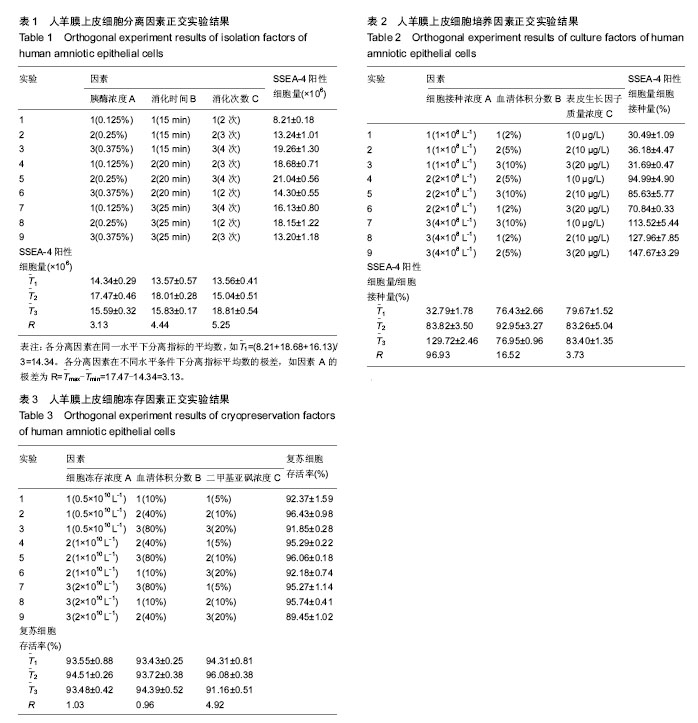| [1] Marongiu F,Gramignoli R,Dorko K,et al.Hepatic Differentiation of Amniotic Epithelial Cells.Hepatology. 2011;53(5): 1719-1729. [2] Niknejad H,Yazdanpanah G.Opposing effect of amniotic membrane on angiogenesis originating from amniotic epithelial cells.Ira J Med Hypotheses Ideas.2014;8(1):39-41.[3] Toshio M,Fabio M,Ewa E,et al.Isolation of amniotic epithelial stem cells.Curr Protoc Stem Cell Biol.2010;Chapter 1:Unit 1E.3.[4] Sean M,Sharina R,Rutu A,et al.Amnion Epithelial Cell Isolation and Characterization for Clinical Use.Curr Protoc Stem Cell Biol.2010;Chapter 1:1E.6.1-1E.6.25.[5] Gita P,Vijesh V,Yang TJ,et al.Changes in culture expanded human amniotic epithelial cells: implications for potential therapeutic applications.PlOs One.2011; 6(11):e26136- e26136.[6] Adinolfi M,Akle CA,Mccoll I,et al.Expression of HLA antigens, beta 2-microglobulin and enzymes by human amniotic epithelial cells.Nature.1982;295(5847):325-327.[7] Satoko Y,Kunihiko T,Yasuharu U,et al.Differentiation of adult hepatic stem-like cells into pancreatic endocrine cells.Cell Transplant.2005;14(9):647-653.[8] Tomoharu T,Isamu I,Shigeo S.Establishment and characterization of a pluripotent stem cell line derived from human amniotic membranes and initiation of germ layers in vitro.Human Cell.2004;17(3):125-130.[9] 程金华,朱化彬,孙秀柱,等.冷冻保护剂和胎牛血清对牛成纤维细胞冷冻效果的影响[J]. 中国畜牧杂志,2006,42(21):12-14.[10] 杨银芬,考桂兰,侯先志,等.不同细胞密度冻存对奶牛乳腺上皮细胞的影响[J].中国细胞生物学学报,2010,32(4):626-629.[11] 郭海平,郭冠萍,郝鹏.BHK21细胞冻存密度与复苏后活力的关系分析[J].畜牧与饲料科学, 2010,31(3):6-7.[12] 陈露萍,王璞,汤海亮,等.不同冻存液对人诱导性多能干细胞冻存与复苏效果的影响[J]. 中国临床神经科学,2012,20(5):494-499.[13] 杨东斌,宋来君,杨波,等.不同人羊膜间充质干细胞冻存液冻存细胞效果比较[J].郑州大学学报:医学版,2009,44(3):568-572.[14] 金玲,陈剑,吴静,等.人羊膜上皮细胞的分离、纯化及其生物学特性研究[J].广东医学, 2010,31(16):2055-2057.[15] Paolo C,Chiara M,Pasquale V.Amniotic membrane transplantation in human immunodeficiency virus-positive children.Arch Ophthalmol.2008;126(6):866-867.[16] 方宁,宋秀军,张路,等.人羊膜上皮细胞的分离、培养及鉴定[J].遵义医学院学报,2009, 32(2):121-124.[17] Tabatabaei M,Mosaffa N,Nikoo S,et al.Isolation and partial characterization of human amniotic epithelial cells: the effect of trypsin.Avicenna J Med Biotechnol.2014;6(1):10-20.[18] Liu X,Zhou Q,Zhang X,et al.In vitro culture and molecular characterization of human amniotic epithelial cells.Xi Bao Yu Fen Zi Mian Yi Xue Za Zhi.2014;30(12):1318-1321.[19] Yang TJ,Vijesh V,Han L Y,et al.Immunogenicity and immunomodulatory properties of hepatocyte-like cells derived from human amniotic epithelial cells.Curr Stem Cell Res Ther. 2012;8(1):91-99.[20] Miki T,Wong W,Zhou E,et al.Biological impact of xeno-free chemically defined cryopreservation medium on amniotic epithelial cells.Stem Cell Res Ther.2016;7(1):8.[21] 李云剑,林樾,燕辛,等.培养基血清浓度对人表皮干细胞增殖分化的影响[J].现代生物医学进展,2010,10(20):3831-3833.[22] Koike C,Zhou K,Takeda Y,et al.Characterization of amniotic stem cells.Cell Reprogram.2014;16(4):298-305.[23] Roy R,Kukucka M,Messroghli D,et al. Epithelial-to- mesenchymal transition enhances the cardioprotective capacity of human amniotic epithelial cells.Cell Transplant. 2013;24(6):985-1002.[24] Elwan MA,Ishii T,Sakuragawa N.Characterization of dopamine D-2 receptor gene expression and binding sites in human placenta amniotic epithelial cells.Placenta.2003; 24(6): 658-663.[25] Marcus AJ,Coyne TM,Black IB,et al.Fate of amnion-derived stem cells transplanted to the fetal rat brain: migration, survival and differentiation.J Cell Mol Med.2008;12(4): 1256-1264.[26] Wang JP.Phenotypic identification and differentiation potential analysis of two kinds of human amniotic cells.Zhongguo Shi Yan Xue Ye Xue Za Zhi.2012;20(1): 146-53.[27] Tan Jean L,Chan Siow T,Lo Camden Y,et al.Amnion cell-mediated immune modulation following bleomycin challenge: controlling the regulatory T cell response.Stem Cell Res Ther.2015;6:8.[28] García-López G,García-Castro IL,Avila-González D,et al.Human Amniotic Epithelium (HAE) as a Possible Source of Stem Cells(SC).Gaceta Medica De Mexico.2015;151(1): 66-74.[29] Toshio M.Amnion-derived stem cells: In quest of clinical applications.Stem Cell Res Ther.2011;2(3):1-11.[30] Drews K,Jozefczuk J,Prigione A,et al.Human induced pluripotent stem cells-from mechanisms to clinical applications. J Mol Med.2012;90(7):735-745.[31] 耿娟娟,崔勇,邱书奇.羊膜上皮细胞的体外培养及干细胞特性研究[J].实用医学杂志, 2012,28(2):172-174.[32] Okere B,Alviano F,Costa R,et al.In vitro differentiation of human amniotic epithelial cells into insulin-producing 3D spheroids.Int J Immunopathol Pharmacol. 2015;28(3): 390-402.[33] Kim S,Kim HS,Lee E,et al.In vivo hepatic differentiation potential of human cord blood-derived mesenchymal stem cells.Int J Mol Med.2011;27(5):701-706.[34] Forte G,Minieri M,Cossa P,et al.Hepatocyte growth factor effects on mesenchymal stem cells: proliferation, migration, and differentiation.Stem Cells.2006; 24(1):23-33.[35] Kang NH,Hwang KA,Kim SU,et al.Potential antitumor therapeutic strategies of human amniotic membrane and amniotic fluid-derived stem cells.Cancer Gene Ther. 2012; 19(8):517-522.[36] Lai D,Wang Y,Sun J ,et al.Derivation and characterization of human embryonic stem cells on human amnion epithelial cells.Sci Rep.2015;5:10014.[37] Tan JL,Chan ST,Wallace EM,et al.Human amnion epithelial cells mediate lung repair by directly modulating macrophage recruitment and polarization. Cell Transplant.2014;23(3): 319-328.[38] Carbone A,Paracchini V,Castellani S,et al.Human amnion-derived cells: prospects for the treatment of lung diseases.Curr Stem Cell Res Ther.2014;9(4):297-305.[39] Hassan N,Ghasem Y.Anticancer effects of human amniotic membrane and its epithelial cells.Med Hypotheses. 2014; 82(4):488-489.[40] McDonald CA,Payne NL,Sun G,et al.Immunosuppressive potential of human amnion epithelial cells in the treatment of experimental autoimmune encephalomyelitis.J Neuroinflammation. 2015;12:112.[41] Grzywocz Z,Pius-Sadowska E,Klos P,et al.Growth factors and their receptors derived from human amniotic cells in vitro.Folia Histochem Cytobiol. 2014;52(3):163-170. |
.jpg)


.jpg)
.jpg)
.jpg)
.jpg)